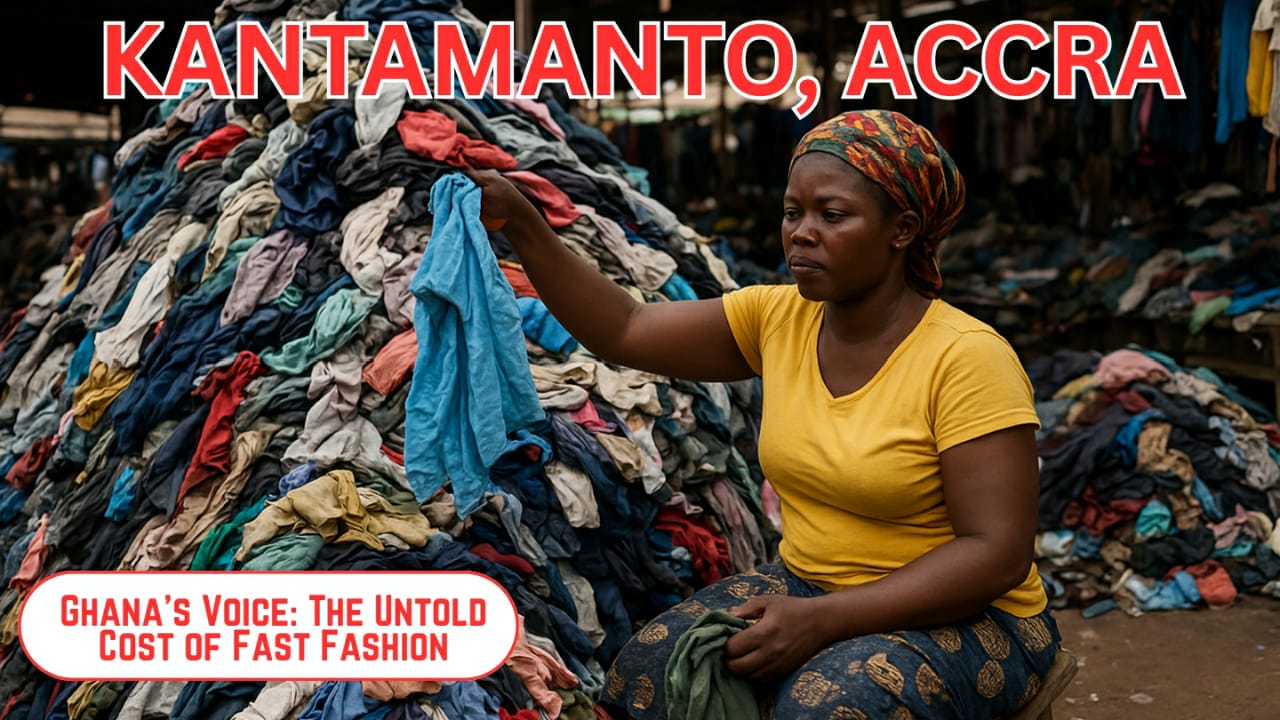Ghana’s Voice: The Untold Cost of Fast Fashion
My curiosity about where our unwanted clothes end up peaked during a visit to Kantamanto Market in Accra last year. The environment was overwhelming: the smell of sun-baked fabric mingled with the clamor of traders. Massive, mysterious bales of second-hand clothes, imported from across the globe, formed towering barricades in the narrow walkways. Cutting a bale open released a deluge of color—hoodies, old jeans, and worn shirts—each bearing labels from foreign countries.
Initially, Kantamanto seemed like a beacon of ingenuity, supporting thousands of livelihoods through global hand-me-downs. However, beneath this busy surface, a grim story emerged. This bustling trade masks a severe environmental crisis that begins far from Ghana and ends up contaminating local drains, beaches, and landfills.
One experienced trader, Afia, bluntly stated the problem: “We can’t sell everything.” She noted that often, “almost half of what’s inside a bale is complete waste.” This observation is supported by a 2024 Greenpeace Africa report, which estimates that up to 60% of imported second-hand clothing is unsellable due to poor quality, damage, or excessive wear. With approximately 15 million garments arriving in Ghana weekly, nearly 40–60% of that volume is instantly discarded.
This textile garbage rarely reaches formal recycling facilities. Instead, it piles up in open dumps, gutters, and shores. A stark illustration is the ragged, 20-meter-high cliff of landfill, composed mostly of clothing, situated along the Korle Lagoon. The Accra Metropolitan Assembly (AMA) dedicates an estimated US$500,000 annually just to manage this textile waste, yet much of it is burned openly, releasing toxic smoke into residential areas. The scale in Kantamanto is immense: the market, which supports about 30,000 people, receives roughly 50 forty-foot containers of these bales every single week.
The Genesis of the Crisis: Fast Fashion
The source of this textile mountain is “fast fashion,” a supply chain model characterized by rapid design, mass production, and quick inventory turnover. Following production outsourcing and acceleration in the late 20th and early 21st centuries, clothing trends sped up dramatically. Consequently, garments are worn fewer times and discarded faster, creating a colossal volume of waste that overwhelms local management systems. Rather than being properly recycled in the originating countries, much of this poor-quality clothing is expediently exported as “second-hand” to nations like Ghana.
The garments arriving fall into three categories: truly wearable second-hand items, repairable or redesignable pieces, and the massive stream of unsellable waste. The core issue is that the proportion of unsellable waste has sharply risen because the quality of exported clothing has plummeted, arriving near the end of its useful life.
The Cost: Environmental, Economic, and Social Damage
The impact of this textile flood is multi-layered:
* Environmental: The waste blocks crucial drainage channels, exacerbating catastrophic flooding. On the beaches near Jamestown, discarded fabric washes up, forming tangled knots dubbed “textile tentacles.” Synthetic textiles shed microfibers, and dyes leach into the soil, severely poisoning ecosystems.
* Economic/Social: Though Kantamanto sustains livelihoods, the sheer volume of waste drains local resources, diverting capital away from value creation. A destructive fire in January 2025 further compounded the economic devastation for traders.
* Cultural/Industrial: Local, traditional Ghanaian textile industries cannot compete with the sheer volume of cheap imported goods, crippling domestic manufacturing capacity.
* Health: The open burning of textile waste releases noxious fumes, and accumulation near homes increases disease and pollution risks.
Local Resilience: Up-cycling and Innovation
Despite the crisis, narratives of creativity and adaptation thrive. Across Accra, local individuals and small businesses are transforming the waste challenge into an opportunity:
* Skilled tailors are actively cutting up unusable items—turning old jeans into patchwork skirts and worn shirts into upholstery.
* Social enterprises are successfully rescuing millions of garments. One organization, for example, claims to have saved over 7 million garments from landfills, redesigning them into new, desirable products.
These positive efforts highlight that the market is both the victim of the problem and a driving force in finding a circular solution.
The Way Forward
Mitigating this crisis requires comprehensive measures:
* Supply-side Reform: Global brands must slow production, enhance durability, and design clothing for maximum reuse.
* Export Quality Control: Only genuinely resalable clothing should be allowed for export, immediately reducing the waste volume.
* Local Development: Resources must be dedicated to scaling up Ghanaian upcycling and redesign initiatives.
* Consumer Responsibility: Consumers in the Global North must reduce consumption, choose higher quality, and understand the true destination of their donations.
* Policy and EPR: Governments must invest in waste infrastructure and enforce Extended Producer Responsibility (EPR) laws, requiring fashion brands to manage the disposal of their own products.
Walking past the colossal piles of fabric in Accra now, I no longer see just trash; I see both a profound global responsibility and immense local possibility. Ghana is not simply bearing the world’s textile burden; it is pioneering the way to rebuild from it. Every reused thread and patch narrates an enduring story of survival, proving that the true afterlife of our clothes begins here—in the markets and workshops of Ghana, where waste becomes a hopeful new beginning.
#pulitzercenter #AccraCityzensHub #fastfashion #environmentaladvocacy #journalism #urbanbetter

